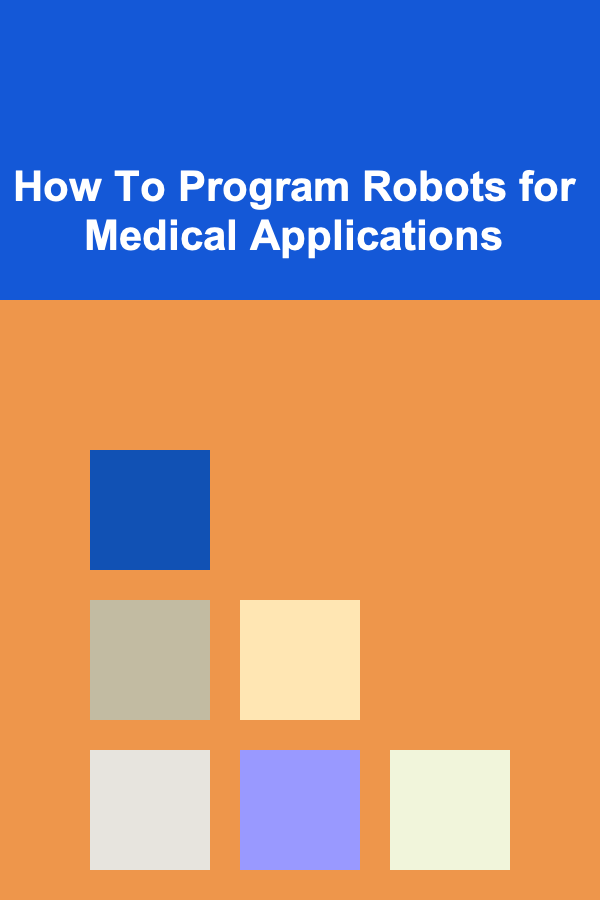
How To Program Robots for Medical Applications
ebook include PDF & Audio bundle (Micro Guide)
$12.99$8.99
Limited Time Offer! Order within the next:

In the modern healthcare landscape, robots are playing an increasingly significant role in transforming medical practices and improving patient care. From performing complex surgeries with high precision to assisting in rehabilitation, robots have the potential to revolutionize the medical field. However, developing robots that can operate safely and efficiently in a medical environment requires a specialized approach to programming. This article explores how to program robots for medical applications, examining the various aspects such as robotics systems, programming languages, challenges, and the future potential of robotics in healthcare.
The Role of Robots in Medical Applications
1. Surgical Robots
Surgical robots, such as the renowned Da Vinci Surgical System, allow surgeons to perform highly complex procedures with great precision. These robots do not operate autonomously but are controlled by the surgeon, who uses a console to guide the robot's movements. The robot enhances the surgeon's ability to perform tasks that require delicate manipulation, minimizing the risk of human error and improving patient outcomes.
Surgical robots typically include components like robotic arms, cameras, and tools that allow for minimally invasive surgeries. These robots enable high-definition 3D visualization and magnification of the operating field, providing greater accuracy during surgery.
2. Robotic Prosthetics and Exoskeletons
Robotic prosthetics and exoskeletons are designed to assist patients with mobility impairments or to enhance physical capabilities. These systems rely on robotic actuators, sensors, and complex control algorithms to mimic human motion. The goal is to restore lost functionalities or provide new abilities to individuals who have undergone amputations or suffer from conditions like paralysis.
For example, robotic exoskeletons enable individuals with spinal cord injuries to regain the ability to stand and walk, providing not only physical rehabilitation but also psychological benefits, improving quality of life.
3. Robotic Assistants for Elderly Care
Robots designed to assist the elderly in daily activities can improve the quality of life for older adults and allow them to maintain a level of independence for longer periods. These robots can perform tasks like medication reminders, monitoring vital signs, and assisting with mobility. In addition, social robots are used for companionship, helping reduce loneliness and increasing mental well-being.
Programming these robots requires a focus on natural language processing (NLP), sensory feedback, and autonomous navigation to ensure the robots are responsive and adaptive to the needs of their users.
4. Robots for Diagnostics and Imaging
Robots in medical diagnostics can be used to automate processes like imaging, sample collection, or even conducting complex medical tests. These robots can perform repetitive tasks more efficiently and consistently than human operators. Additionally, some robotic systems are used in laboratory environments to perform high-throughput screening or to analyze medical images for anomalies such as tumors or fractures.
5. Telemedicine and Remote Robotic Surgery
Telemedicine, which allows healthcare providers to diagnose and treat patients remotely, can also benefit from robotic systems. With the help of teleoperated robots, surgeons can perform surgeries or consultations without being physically present. Remote robotic surgery combines both telecommunication and robotic systems to enable surgeons to operate on patients across vast distances, making it possible to treat patients in underserved areas with highly skilled expertise.
Key Components of Robotic Systems for Medical Applications
Before diving into how to program robots for medical applications, it's important to understand the key components that make up a typical medical robot.
1. Sensors
Sensors are crucial for robotic systems, as they enable robots to interact with their environment. Medical robots rely on sensors to detect obstacles, monitor vital signs, and provide real-time feedback to operators. These sensors may include:
- Cameras for visual input (e.g., endoscopes for surgeries).
- Force and tactile sensors to provide feedback during surgeries or rehabilitation tasks.
- Proximity sensors to detect nearby objects and prevent collisions.
- Biometric sensors for monitoring patient health metrics like heart rate or oxygen saturation.
2. Actuators
Actuators are the components responsible for moving a robot's parts. They convert electrical signals into mechanical movement. In medical robots, actuators need to be precise and reliable to ensure that the robot can perform intricate medical tasks. Pneumatic actuators, hydraulic actuators, and electric motors are commonly used in medical applications.
3. Control Systems
The control system is the brain of the robot. It processes input from sensors and translates that information into commands that control the actuators. In medical robots, the control system must be capable of high precision and adaptability to ensure that the robot behaves predictably in all situations.
Control systems may include a combination of software, hardware, and algorithms that allow the robot to follow predefined paths, avoid obstacles, or respond to commands from a surgeon or medical professional.
4. Software and Programming Languages
Programming is a critical component of any robotic system. The software allows the robot to perform specific tasks, interpret sensor data, and communicate with other devices. Several programming languages and frameworks are used for developing medical robots:
- C/C++: These low-level programming languages provide direct control over hardware components and are commonly used for high-performance robotic applications, such as surgical robots.
- Python: Known for its simplicity and flexibility, Python is often used for machine learning, data analysis, and scripting robotic tasks in healthcare applications.
- ROS (Robot Operating System): ROS is an open-source framework that provides a collection of libraries and tools for building robot applications. It is widely used in research and development of medical robots.
- MATLAB/Simulink: These platforms are used for modeling, simulation, and control system design, often employed in medical robots that require complex calculations.
5. User Interface (UI)
Medical robots often require user interfaces for medical professionals to interact with them effectively. The UI provides an intuitive means for operators to control and monitor the robot's actions. In robotic surgery, for instance, the surgeon may use a console with controls for manipulating the robot's arms, cameras, and tools.
In elderly care robots or rehabilitation systems, the UI might include a touchscreen or voice-controlled interface that allows patients to interact with the robot.
Steps to Program Robots for Medical Applications
Programming robots for medical applications involves several key steps, from designing the robot's control system to implementing safety features.
1. Defining the Requirements
The first step in programming a medical robot is defining its requirements based on the medical task it is intended to perform. This includes understanding the robot's capabilities, the needs of the medical professionals or patients who will use it, and any regulatory or safety standards the robot must comply with.
For instance, a robotic surgical assistant must be able to perform precise movements, avoid causing harm, and allow the surgeon to maintain control at all times. On the other hand, a robot designed for elderly care may need to prioritize ease of use and emotional interaction, with features like voice recognition and automated reminders.
2. Designing the Robot's Control System
The control system is designed based on the robot's required tasks and functionality. This step involves choosing the right sensors, actuators, and control algorithms to ensure smooth operation. The software architecture of the control system must handle inputs from sensors, process data in real-time, and translate that data into commands for the actuators.
For surgical robots, for example, the control system needs to be highly responsive with low latency to allow real-time control over delicate movements. It also needs to ensure that the robot follows the surgeon's instructions precisely, avoiding any unintended movements.
3. Implementing Safety Features
In medical applications, safety is paramount. Programming must include robust safety features that prevent accidents and ensure patient well-being. Some key safety features include:
- Emergency stop mechanisms: A fail-safe feature that allows the operator to immediately stop the robot in case of a malfunction or error.
- Collision detection: Sensors that can detect when the robot is about to collide with an object, prompting an automatic stop or adjustment of the robot's trajectory.
- Redundancy: Backup systems that ensure the robot continues to function safely even if one component fails.
4. Machine Learning and Adaptation
Machine learning can be a powerful tool in medical robotics, especially in applications where adaptability is essential. For instance, a robot might be trained using machine learning algorithms to recognize patterns in medical images, detect anomalies, and even assist in diagnostic tasks.
In rehabilitation or prosthetics, machine learning can be used to adapt the robot's actions based on the user's progress or needs. The robot might learn the user's gait pattern or muscle strength over time, adjusting its movements to optimize recovery.
5. Testing and Validation
Before a medical robot is deployed, extensive testing and validation are necessary to ensure it performs as expected and adheres to regulatory standards. This testing phase may involve:
- Simulations: Running virtual tests to evaluate the robot's performance in various scenarios.
- Clinical trials: Testing the robot in a real medical environment, with human participants, to assess its safety and effectiveness.
6. Deployment and Maintenance
Once the robot has passed testing and validation, it is deployed for medical use. Continuous maintenance and monitoring are necessary to ensure the robot remains functional and up-to-date. Regular software updates, hardware checks, and system diagnostics are vital for maintaining optimal performance.
Challenges in Programming Robots for Medical Applications
While medical robotics offers tremendous potential, programming these robots presents several challenges:
1. Complexity and Precision
Medical robots must perform highly precise and complex tasks. Programming for such applications demands attention to detail and the ability to handle sophisticated algorithms that account for multiple variables and real-time feedback.
2. Safety and Reliability
Safety is a top priority in the medical field. Even a small error in programming can have serious consequences. Developers must ensure the robot's software is reliable and safe, with mechanisms in place to prevent accidents.
3. Regulatory Compliance
Medical robots must comply with strict regulations set by health authorities, such as the U.S. Food and Drug Administration (FDA) or the European Medicines Agency (EMA). Programming medical robots involves adhering to these standards to ensure patient safety and regulatory approval.
4. User Interaction
Medical robots often require human interaction, and designing user-friendly interfaces for medical professionals or patients can be challenging. It's crucial that the robot's interface is intuitive and accessible to those with varying levels of technological expertise.
Conclusion
Programming robots for medical applications is a challenging yet rewarding endeavor that has the potential to revolutionize healthcare. From surgical robots to robotic prosthetics and exoskeletons, the scope for innovation is vast. As technology continues to evolve, the development of more advanced, precise, and adaptable robotic systems will play a crucial role in improving patient outcomes and making healthcare more efficient.
As developers, engineers, and medical professionals work together to overcome challenges and integrate new technologies, robots will continue to transform the medical field, enhancing both the practice of medicine and the lives of patients. The future of robotics in healthcare is bright, with endless possibilities for innovation and improvement.

How to Incorporate Outdoor Lighting to Enhance Your Garden
Read More
How to Keep Your Bathroom Counter Clutter-Free
Read More
How to Optimize Your Dropshipping Ads for Mobile Geotargeting: A Comprehensive Actionable Guide
Read More
The Art of Disruption: How to Stand Out by Challenging the Status Quo
Read More
Why You Should Use Clear Containers for Storage
Read More
How to Track Retirement Savings Contributions and Adjust Your Strategy
Read MoreOther Products

How to Incorporate Outdoor Lighting to Enhance Your Garden
Read More
How to Keep Your Bathroom Counter Clutter-Free
Read More
How to Optimize Your Dropshipping Ads for Mobile Geotargeting: A Comprehensive Actionable Guide
Read More
The Art of Disruption: How to Stand Out by Challenging the Status Quo
Read More
Why You Should Use Clear Containers for Storage
Read More